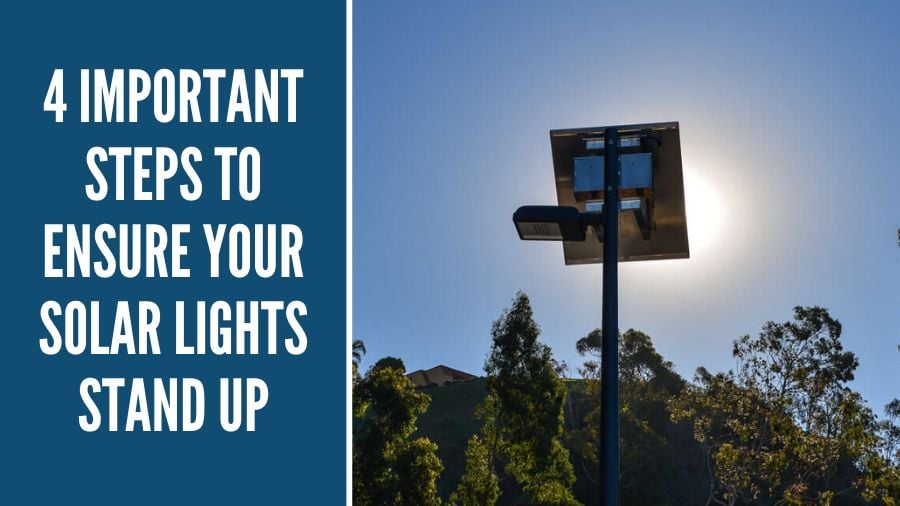


You have made the final purchase, and your solar lights are coming. Here are some tips before you install the light systems to make sure they stand up to the test of time. Have your lights already been installed? These tips can help ensure your lights are installed properly and will continue to work flawlessly year after year.
I hate manuals as much as the next person, but let me tell you, taking the time to read the installation instructions for your new solar lights is absolutely worth it. Trust me, it will save you time and frustration down the road. You see, the installation manual is a treasure trove of helpful information that can ensure your system is installed properly and all the requirements are met.
Not only does the installation manual provide step-by-step instructions for setting up your solar lights, but it also includes valuable troubleshooting tips. This means that if you encounter any issues during the installation process, you can quickly refer to the manual and identify what might have gone wrong. It's like having a guidebook that guarantees a smooth installation experience.
So, even though reading manuals may not be the most exciting activity, take a moment to review the installation instructions for your new solar lights. Trust me, it's a small investment of time that will pay off in the long run. Your future self will thank you for it, and you'll have peace of mind knowing that your solar lights are installed properly and ready to provide you with years of reliable lighting.
Well, this one is a no-brainer, but it's surprising how many people overlook the importance of installing solar systems in direct sunlight. I've witnessed countless instances where both large and small solar systems were installed in shaded areas, and let me tell you, it's a recipe for disaster. If your solar panel is not exposed to full sun throughout the day, it simply won't be able to generate enough power to charge the battery and provide adequate lighting at night. It's as simple as that.
Think of your solar panel as a hungry plant that needs sunlight to thrive. Just like a plant in the shade struggles to grow, a solar panel in the shade struggles to produce the energy it needs. Without sufficient sunlight, your solar system will quickly become ineffective and fail within a matter of days.
So, when you're installing your solar lights, make sure you choose a location that receives ample sunlight throughout the day. Avoid placing them in areas shaded by trees, buildings, or other obstructions. Remember, the more sunlight your solar panel receives, the more power it can generate and the longer your lights shine brightly at night.
When you receive your solar light system, you must check for any labels on the wires or parts of the system. These labels are a valuable resource that shouldn't be overlooked. Take the time to read them carefully and follow the directions provided.
Labels are often added when there are minor changes to the installation manual. They ensure that the system is put together properly and reduce the chances of any mistakes or mishaps during the installation process. By reading all the labels before you connect the wires, you can ensure you don't overload the system and blow fuses.
Each label contains specific instructions and guidelines that are crucial for the proper functioning of your solar light system. These instructions may include information on wire connections, voltage requirements, or safety precautions. By adhering to these instructions, you can ensure that your solar light system operates efficiently and safely.
By paying attention to the labels and following the instructions, you can maximize the performance and longevity of your solar light system. So, don't overlook this important step and enjoy the benefits of a well-installed and adequately functioning solar lighting system for years.
Like your car and house, a solar lighting system requires regular maintenance to ensure optimal performance and longevity. While the maintenance required for solar lights is minimal, it is essential to follow a few key steps to ensure that your lights continue to shine bright.
Firstly, it is important to replace the batteries in your solar lights at the end of their life span. Over time, the batteries in your solar lights will naturally degrade and lose their ability to hold a charge. By replacing them when necessary, you can ensure that your lights continue functioning properly and provide reliable lighting at night.
Additionally, if you live in a dusty or dry area, it is important to clean off the solar panel every so often. Dust and debris can accumulate on the panel, reducing its ability to absorb sunlight and generate power. Simply wiping down the panel with a soft cloth or using a gentle spray of water can help to keep it clean and functioning effectively.
By performing regular maintenance on your solar lighting system, you not only ensure that your lights continue to function flawlessly but also allow yourself to identify any potential issues or problems that may arise in the future. Regular maintenance can help you catch and resolve any issues before they become major problems, saving you time and money in the long run.
So there you have it. No matter if you are using a commercial solar light system or a small landscape light, installing it properly and keeping up with the system will ensure your system will work flawlessly for years to come. Since most commercial solar light systems last 25+ years, make sure you get every moment of light these systems can provide.
